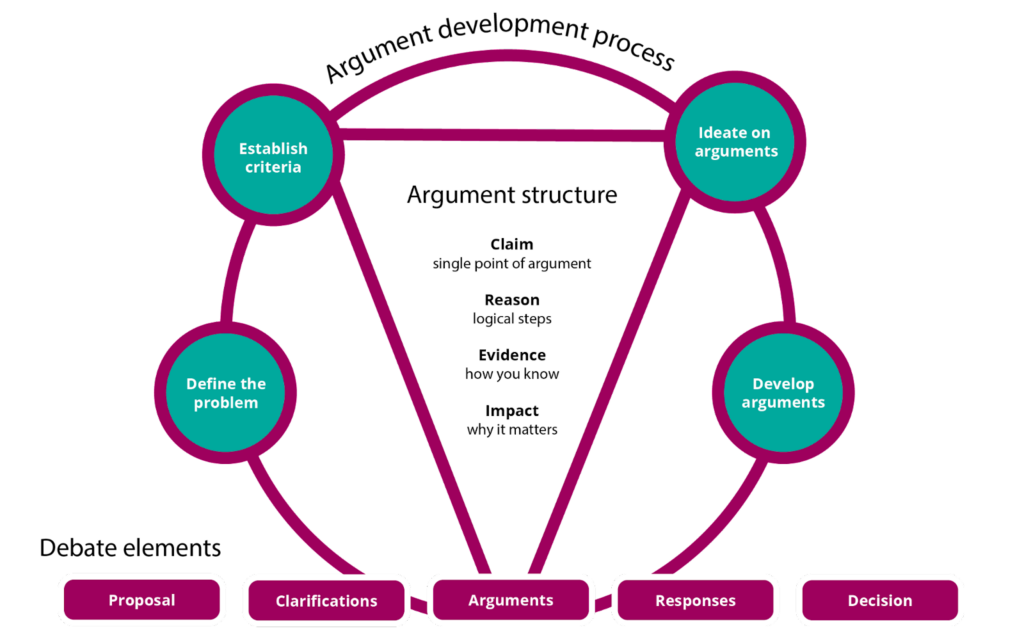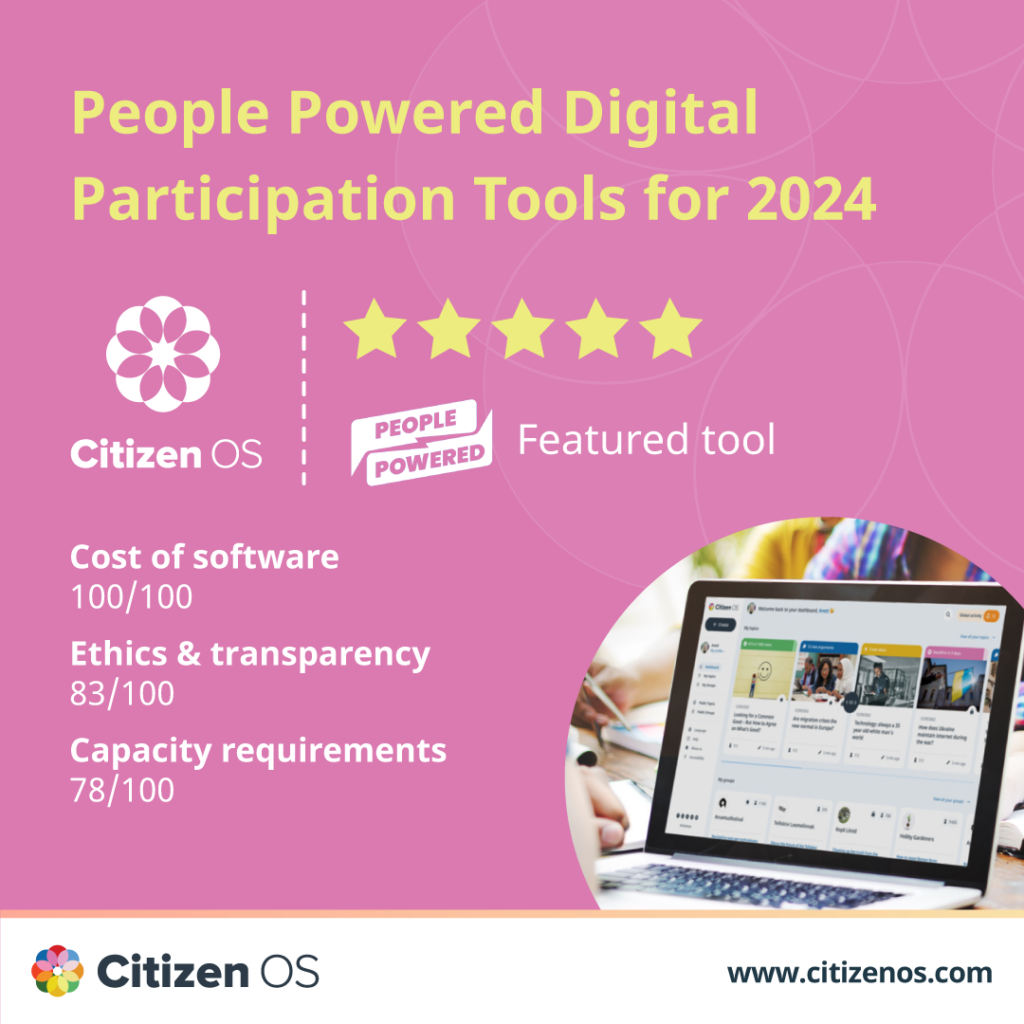Andee Pittman, one of the participants of our Democracy Defenders Accelerator wrote an article to Apolitical about how rational debate can create a more effective and democratic public service bringing along more inclusion and transparency.

Andee Pittman at the Democracy Defenders Accelerator Bootcamp in Estonia. Photo by Meelika Hirmo.
- The problem: There is a lack of capacity and resources to include rational debate in decision-making within the public service.
- Why it matters: Rational debate reduces bias, increases inclusivity and enables accountability and transparency in decision-making. Without it, we hinder public service effectiveness, inclusiveness and innovation.
- The solution: Incorporating rational debate into internal decision-making processes using new practices and tools.
Having recently returned from Estonia, where I participated in a 10-day bootcamp as part of the Democracy Defenders Accelerator programme by Citizen OS, I realised research and design are not enough – we need more debate in our public service development practices.
Citizen OS is a non-governmental organisation (NGO) that provides a free, open-source, digital platform for debate. They also deliver international training programmes to encourage global cooperation and new civic actions. At the bootcamp, the founder of CitizenOS, Margo Loor, taught us about argumentation and rational debate. It was here that I saw how these essential democratic practices are not just for the political side but have a place in the public service as well. The public service needs input from a diversity of stakeholders and we make a lot of important decisions that impact our service delivery. Even though many teams are starting to use modern research and design practices to inform their work, there is often not enough time to truly challenge ideas and have debates included in decision-making. This feeds bias, entrenches exclusivity and stifles innovation. Further, the criteria for decision-making are not always transparent, which leads to a lack of accountability and the ability to learn from decisions.
By enhancing our decision-making process to include rational debate, we can combat our biases, measure the effectiveness of decisions and align more with our core values.
Then I thought, how might the inclusion of debate transform Canada’s public service philosophical phrase, “fearless advice, loyal implementation”? What makes us fearless? And why is it that so many decisions are painful to implement?
The benefits of debate
Including rational debate in our decision-making can make our delivery more effective and innovative. It does this by reducing bias and by increasing inclusivity and transparency. How can we find new possibilities if there’s little space to learn from mistakes, challenge ideas and be inclusive in the process?
Reducing bias
More minds participating in a debate or decision helps to reduce observer bias by providing more interpretations of evidence and the ability to challenge each other’s conclusions. Additionally, studies have shown that when people switch sides from their point of view, referred to as a “consider-the-opposite” strategy, they reduce their assimilation bias – the strengthening of their previously held beliefs instead of growing their appreciation for other sides (T. L. Budesheim, A. R. Lundquist, 1999). Further, a debate could be considered another form of research, a meta-research, on how and what people consider as evidence. I believe the public service is starting to realise that many harmful biases are embedded in our operations, so I think the time is right to consider debate as a key tool to support rigour in our decision-making processes.
More inclusive
The pandemic taught many of us that having a process and structure for dialogue enables more contributions from those who may not be as able to participate in an unfacilitated discussion. It did this by forcing us to raise our digital hand to speak. This is supported by the science of meetings – a whole field of study dedicated to understanding what happens prior to, during, and after meetings. Structure and facilitation supports creative thinking, discussion, information sharing and decision-making. This in turn can help organisations increase employee engagement, affiliation, and perceptions of supervisor support (K. A. Khaler et al., 2022). Debate provides the structure and facilitation for dialogue and decision-making, which allows us to argue in a more safe and accessible way.
Increases transparency
Another problem that debate helps solve is ensuring defined and transparent criteria for decision-making. How many of you have questioned whether decisions have appropriately factored in the importance and impact of all the evidence? If the criteria are not clear and integrated into the process, it’s harder to hold decision-makers accountable for not aligning decisions to the evidence, principles and objectives of the organisation. This in turn makes it harder to learn from less effective decisions because we have less information about the decision-maker’s rationale. Ultimately, the debate process can build alignment, collective wisdom and shared responsibility.
Incorporating rational debate into our decision-making processes not only fosters greater effectiveness and innovation, but also equips us to challenge biases, harness collective wisdom and navigate complex issues, making it a crucial tool for cultivating a more accountable and democratic public service.
Debate and argumentation – the basics
Debate and argumentation are core to our political processes. For example, it is used in the Canadian House of Commons when making decisions or for electoral candidates to argue for their platform. While a debate may have different procedures, the core elements remain the same:
- A proposal is made to a group
- Clarifications are made and questions are answered
- Arguments are provided, in support of or against the proposal
- Responses are provided that acknowledge, refute or counter the arguments
- Voting and decision-making
Following the structure of a rational argument is key to ensuring a clear and supported point. It’s important that only a single idea is presented at a time. Unlike a research paper that chunks together all information, an argument is a slice of pizza that can be presented and dissected on its own. The structure:
- Claim: What is the single point the argument will raise?
- Reason: Why or how it matters, what is the logical step from issue, to proposal, to outcome?
- Evidence: How do you know? This brings the argument into reality and centred on the problem at hand.
- Impact: Why does it matter?
In teams, we practised the following process for developing arguments. The process was familiar to me as it aligns with the design-thinking process.
The argument development process:
- Define the problem. Teams that use modern design research already do this well. Including the problem statement in the process helps to ensure that arguments are anchored to the problem you’re trying to solve.
- Establish criteria for decision-making. This is a critical step! Before entering the debate, there need to be agreed-upon criteria for decision-making. These criteria enable everyone to weigh the arguments appropriately to better judge their importance in the decision.
- Ideate on the key arguments. This step is where we can increase our inclusivity in the decision-making process. By enabling stakeholders to contribute points of consideration to an argument, you can have a more holistic understanding of the impacts and better quantify them. And with new AI tools making trend analysis more accessible, crowdsourcing input has never been easier.
- Develop the arguments with evidence. Using the structure above, you can collect the evidence you need to support the proposed arguments. Through the development process, you tie together all the pieces of evidence to the impacts, which helps to ensure a clear rationale between an argument and the evidence that supports it.
I went into this session thinking I knew what debate was, but I had a stale, inflexible version of the practice in my head. Margo Loor provided me with new insights into the practice and how modern tools can adapt the debate process and apply it in new contexts. Going through this process with a group of participants from around the world made me see the benefits and challenges of incorporating this into my work in public service.

Debate elements. Source: Apolitical.co
How to adopt rational debate in 2023
From my experience, a lack of resources is a key challenge to implementing more inclusive practices in our work. So changing decision-making processes will be no exception! The more democratic the process, the more time and energy it takes. Margo’s opening statements in the lesson included the fact that humans have limited conscious attention. According to a 2017 MIT study, humans can only consciously pay attention to 120 kbit of information per second. Knowing how overworked many of us are, how can we make it easier to be conscious of the most important information and bring unconscious bias out?
These are some strategies I have identified to try in my environment:
- Use new tools. Asynchronous debating with the use of online tools like Citizen OS can make the process easier for busier schedules. This platform is free to use, has public and private groups, and is designed for rational debate and decision-making processes.
- Be selective with what decisions are debated. Try including debate in strategic, high-impact decisions where stakeholder participation would be essential and meaningful.
- Practice! Once people become familiar with the basic procedures, debating can be more efficient. Structured processes around decision-making may not be natural to some and so it may take time for this to become a tool a team reaches for.
- Embed debate into the design and delivery process. By having smaller, more regular debates, the process can be quicker while still realising the benefits. (Like we do with user research, right y’all?) It will also be easier to prove the value to decision-makers higher up the chain once it’s more normalised for the working level.
- Be creative in the design of the debate and decision-making procedures. Use facilitation to make the process dynamic and engaging.
Join me in trying these strategies! I’ll be sure to update you all on how it goes and I welcome you to do the same. Follow me on LinkedIn or Threads to follow me on this journey.
So, is our public service philosophical phrase still relevant?
I still agree we need to give fearless advice and to loyally implement whatever decision is made. But what is making us fearless? Is it from our biases or is it from a well-debated inclusive process? Are we implementing loyally but begrudgingly, or are we supportive because we can measure the effectiveness of a decision based on having transparent criteria? By enhancing our decision-making process to include rational debate, we can combat our biases, measure the effectiveness of decisions and align more with our core values in a democracy. So perhaps we would be better served to say, “fearless debate, loyal implementation”.
Ready to shape the future of our public service through fearless debate and collaborative decision-making? Or do you think there’s a better way of improving our outcomes than including debate in our processes? Add to the debate on Citizen OS and be part of the transformative journey towards a more effective, inclusive and democratic public service.

This is the heading
Lorem ipsum dolor sit amet, consectetur adipiscing elit. Ut elit tellus, luctus nec ullamcorper mattis, pulvinar dapibus leo.




